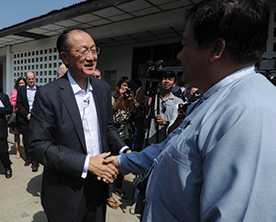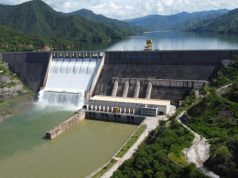The World Bank has announced that it will team up with the Department of Water Resources to develop the Ayeyarwaddy Basin, by providing a US$ 100 million loan.
The project, on which work will begin in January 2015 , and is expected to take six years to complete, will upgrade inland wa- ter transport and build weather information centres, which will provide information about climate impacts on the people living in the area. The project will be implement- ed in three stages and will include improv- ing transport routes along the Ayeyarwaddy River, support systems for water resource management teams, capacity building and improving information systems. The loan provided by the World Bank is interest-free and does not need to be repaid for 10 years, the World Bank said.
Myanmar is currently in a triple transition – from an authoritarian military system to democratic governance, from a centrally di- rected economy to a market-oriented econo- my, and from 60 years of conflict to peace in its border areas. These transitions have the potential to create opportunity and shared prosperity for the people of Myanmar and for the country to resume its place as one of the most dynamic economies in Asia.
As the largest country in mainland South- east Asia, Myanmar has one of the lowest population densities in the region, with fer- tile lands, significant untapped agricultural potential, and a rich endowment of natural resources. Its geographic location at the intersection of China and India, two of the world’s most dynamic economies, makes it well positioned to resume its traditional role as a regional trading hub and a key suppli- er of minerals, natural gas, and agricultural produce.
Since 2011, the government has embarked on an ambitious economic, political and governance reform program. It has begun a series of reforms to remove economic dis- tortions, such as floating the currency, new fiscal regulations to rationalize personal in- come tax and reduce consumption tax, lib- eralizing the telecommunications sector, re- forms aimed at developing the private sector and stimulating direct foreign investments, a review of the financial sector, promotion of access to finance, and creating an environ- ment conducive to job creation These reforms are paying off. Myanmar’s economy is estimated to have grown by 8.3% in FY2013/14, driven mainly by construc- tion, manufacturing, and services. Recovery in agriculture is estimated to have contrib- uted to the growth. The economy is project- ed to expand further by 8.5% in FY2014/15, led by gas production and investment. The outlook for Myanmar remains positive, although this remains dependent on sus- tained reforms in several policy areas.
In FY2013/14, the country’s GDP was esti- mated at $56.8 billion. Based on the prelim- inary population figure of 51.4 million from the national census conducted in March/ April 2014, the country’s per capita GDP is around $1,105, one of the lowest in East Asia and the Pacific. Analysis of the last nationwide Integrated Household Living Conditions Assessment (IHLCA) conducted in 2009/10 found that 26% of the popula- tion is living below the poverty line, though further detailed analysis by the World Bank – taking into account nonfood items in the consumption basket and spatial price differ- entials – brings poverty estimates as high as 37.5 percent.
Once the top exporter of rice in the world, Myanmar’s rice exports now account for a negligible share of the world market. Myan- mar’s exports of natural resources such as gas and gems are becoming increasingly significant.
Most social indicators are very low. For example, 32% of children under five suffer from malnutrition. Limited access to and the poor state of infrastructure are major impediments to providing basic health and education services and for economic devel- opment. Almost half the roads are not pass- able during the monsoon season.
Telecommunications and internet access are also very limited. About 73% of the
population lacks access to electricity. The consumption of electricity– 20 times less than the global average— is one of the low- est in the world. Existing power infrastruc- ture meets only about half of the current demand, resulting in frequent blackouts and the rationing of the electricity supply. Access to drinking water is also limited in many areas.










